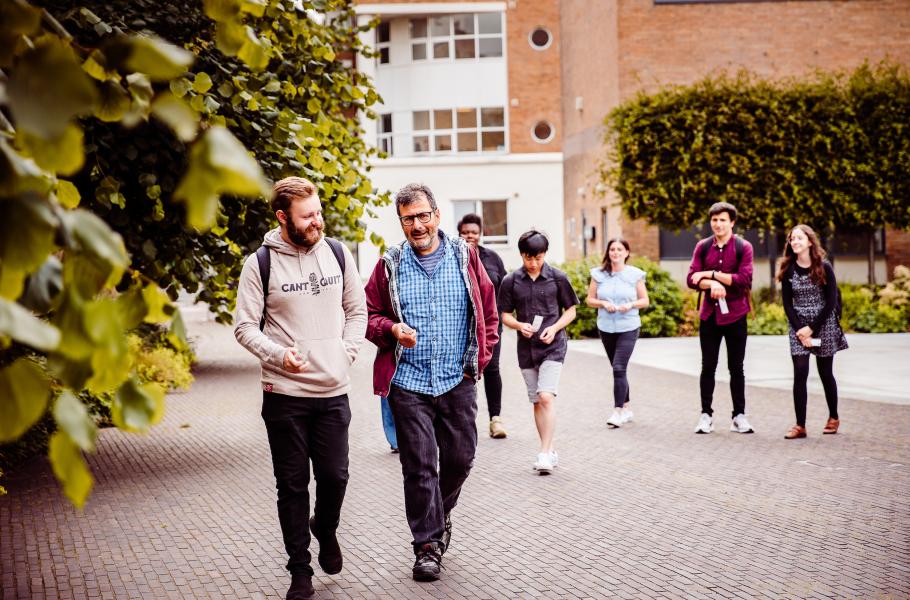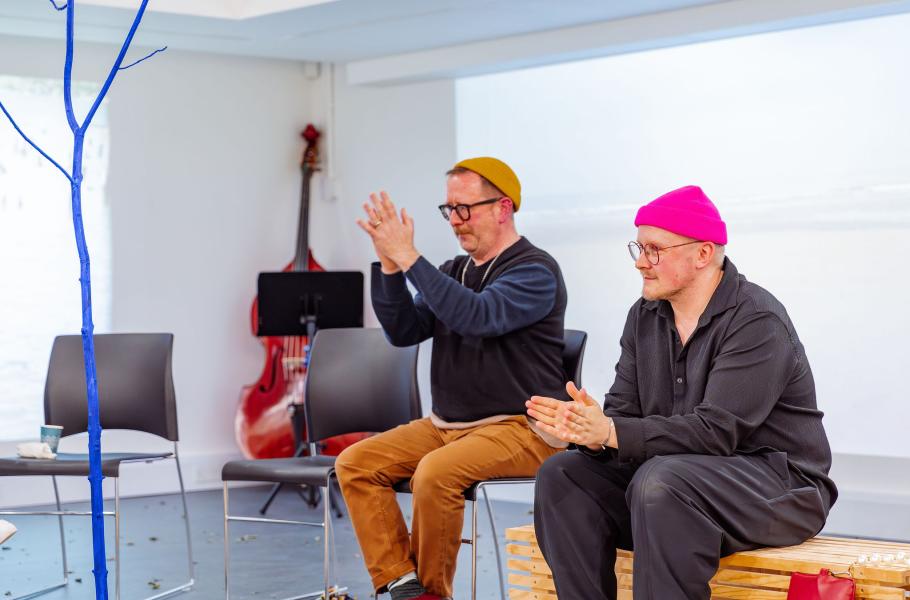Hand in Hand: testing an intergenerational art practice
We have been programming ‘children's’ or ‘family’ work for several years, but we have never quite felt comfortable with it. I was having a chat with an old colleague, a single man, whilst sitting in our gallery four or five years ago. He was saying, ‘for me, the trouble with family work is that I’m not invited.’ And as we talked it over further, he felt that family programmes addressed the 2.4 children model, often reflected in the reduced ticket bundles on offer at many venues. And he was right. It can shut people out.
I’ve always felt uncomfortable with theatre or artwork that is made for exclusive groups. This happens a lot with work for children, as it is often explicitly made for a certain age bracket. No doubt the point of these divisions is to consider the learning/comprehension abilities of different age groups, but at the same time, it excludes those that do not ‘fit’ and closes their opportunity to benefit from an experience. If it is billed as suitable for 7–10-year olds, I know that my 11-year-old will refuse to go. At Lancaster Arts, we thought a lot about what it means when you don’t feel invited. Of course, not everything can be for everyone. But it did get us thinking about what a cross generational programme could look like and specifically, how we make invitations to all the work we present.
A few of us at Lancaster Arts have young children. We have found ourselves complaining about the poor investment in a lot of work ‘for children’. As my children grew, I became aware over the years that I was often seeing things ‘for’ them… I was there to service their experience. This, of course, has its place, and I love to try and see the world through their eyes. But I also wanted something else. What artworks were out there for me and my children, where we could have a genuinely shared experience, and all come away feeling stimulated and nourished?
Excuse the pun, but it was a breath of fresh air seeing the wind-powered L’Apres-midi dun Foehn by Non Nova at the Edinburgh festival a few years ago. Such a simple premise: No text. Claude Debussy’s Afternoon of a Faun playing. In the audience, babies were on shoulders and children sat on the floor. Adults sat on chairs of differing heights, which were set in the round. Where people could stand, they did, so they could get the best possible view. And then in happened. A man manipulated plastic bags and set them in a vortex made of domestic fans positioned inside the playing space circle. And the bags danced. And oh, how they danced. All of us watching, ranging in age from probably six months to eighty or so, looked on in awe. At pauses in the music, you could have heard a pin drop.
As we were sat in the round, I could see nearly all the audience… of every age… open mouthed in wonder. It was a beautiful performance. And as I watched all those faces, it felt like a truly intergenerational experience. But what was it about this experience that invited us all? Was it the absence of text, that required no complex deciphering for the youngest audiences? Was it the pure and exquisite simplicity of idea, with no narrative to follow, that allowed for an equality of experience? Was it the quiet and dogged skill of the performer, manipulating that floppy, shiny material, and making it come to life – that elusive theatre magic that we all hope to witness when walking into those dark spaces? Whatever it was, it was definitely food for thought.
Off the back of some of this thinking around what intergenerational art could be, my colleague Harriet Hill-Payne and I undertook a research project with a group of artists, called All Together* at Lancaster Arts. As a producer/artist team, we developed three inter-connected workshops that genuinely ‘spoke to’ and included all generations. The workshops each used a different art form. Dave led a visual arts workshop, that focused on unconventional painting. The dance workshop was led by Fabiola and Jenny, and explored (sometimes difficult) emotions and connections through movement. Ben and Anni’s music and sound workshop invited participants to engage through non-verbal communication.
Throughout the action research project, we explored the ‘key conditions’ that contributed to a meaningful intergenerational experience for those taking part. We made the following discoveries:
- Connection: It was important that the participants felt connected (to their family, and the wider group). Adults and children were often sharing the same creative experience, being ‘in the moment’ with each other and joining in heart and mind.
- (Disguised) Rules: Rules for taking part were helpful for participants, as the limits set up by the artists actually enabled creative exploration and family bonding in the workshops.
- Empowering Children: It was vital to empower the children. The artists were aware of the importance of acknowledging the children’s behaviour (though language, mirroring, or a response) as a way of developing their confidence and independence.
- Empowering Adults: We discovered that the adults needed to be empowered too. Adults were given space to have their own personal journeys, and this was crucial in shifting their experience.
- Use of Language: We found that a consideration of language was important. The usual hierarchical structure of adults as speakers, leaders and observers and children as listeners, followers and doers was challenged in the workshops. The artists found ways to democratise language, as they narrated, without judgement, the participants’ experience, or removed language all together by communicating non-verbally.
- All Together – Me and You: Feeling like you matter makes the social possible. You can’t help and support those around you unless you are well supported and safe yourself. In this project, the artists and participants were held in a supported and caring environment, where listening and acknowledgment were key. This equality of experience made the sharing and connection possible.
It was the notions of equality and togetherness that seemed to really define the intergenerational experience in this project… but of course these won’t necessarily be the pre-conditions for any intergenerational experience, and the level of mindfulness around the relationships in the room will not always be under our control when work is produced and made in other contexts.
We dipped our toes in, really. It felt like the beginning of something. The beginning of exploring what it means to have the widest range of ages as participants or as an audience, and how they can genuinely share an artistic or creative experience. It felt full of possibility.
Post-pandemic, our next step is taking this thinking forward. We recently considered how to reach an intergenerational audience for Something's Happening Here, the inaugural event for the Lancaster Heritage Action Zone cultural programme, called Mill Race: Flow of Change (you can see an image from the event on this page). Over the next six months we will work with other artists to apply and develop our learning, not least in our up-and-coming intergenerational commission in collaboration with Z-arts in Manchester, called Hand in Hand. See the details here!
Alice Booth is the Creative Producer with Lancaster Arts.
*The All Together took place in 2019 with artists David Hulston (Visual Artist, based in Manchester), Fabiola Santana & Jenny Reeves (Dance Artists, based in Liverpool and Lancaster) and Ben McCabe and Anni Tracy (Musicians, based in Lancaster). The project was designed and produced by Alice Booth and Harriet Hill-Payne from the Lancaster Arts team.




